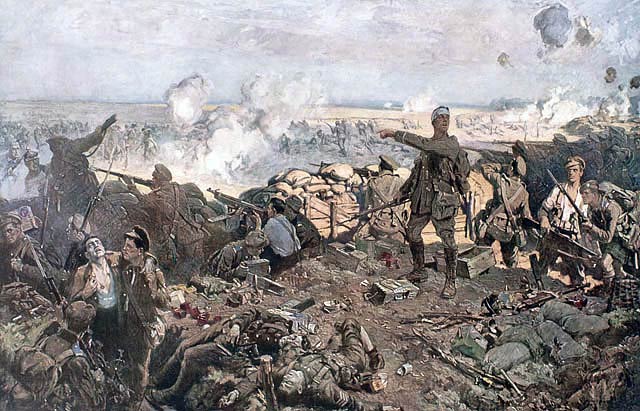| Second Battle of Ypres | |||||||
|---|---|---|---|---|---|---|---|
 |
|||||||
|
|||||||
| Contenders | |||||||
| Unit Strength | |||||||
| 8 infantry divisions | 7 infantry divisions | ||||||
| Casualties and Deaths | |||||||
| Total: | Total: | ||||||
| 70,000 dead, wounded, or missing | 35,000 dead, wounded, or missing | ||||||
| Part of World War I | |||||||
The Second Battle of Ypres is historically significant for being the only major offensive initiated by the German military at the Western Front. Most infamously, this battle also served as a testing ground for releasing chlorine gas as a weapon of mass destruction.
Fighting on the Eastern Front
The Germans wished to gain an advantage over the Allied Forces at the Eastern front where defeating the Russians proved to be extremely difficult. Through launching an attack on a Belgian city, the attention of the Allied Forces could be diverted. The attack itself was not even considered successful as the Germans were never able to actually take the town.
The Attack on Ypres
Belgium experienced six major military engagements over the course of the Battle of Ypres. The first engagement took place on April 22, 1915, and the last would occur on September 25, 1915. The German army would do battle with a collective of troops from Canada, Africa, France, Britain, India, Belgium, and Newfoundland.
One of the historical footnotes of this battle was that Canada would become the first former colony to defeat a major European power in Europe.
Aftermath of the Battle
 The end result of the battle was a brutal one. The Germans suffered roughly 35,000 casualties. The Allied forces would lose upwards of 70,000. The civilians of Ypres suffered tremendously. When the Germans realized they could not take the town, they simply launched a bombardment on it. The entire town was destroyed. Rebuilding it would take decades.
The end result of the battle was a brutal one. The Germans suffered roughly 35,000 casualties. The Allied forces would lose upwards of 70,000. The civilians of Ypres suffered tremendously. When the Germans realized they could not take the town, they simply launched a bombardment on it. The entire town was destroyed. Rebuilding it would take decades.
Using Chemical Weapons
The Battle of Ypres was not the first instance of using chemical weapons in World War I. Previous uses and attempts occurred, but they were failures. In the Battle of Bolimov, for instance, cold weather turned the gas into liquid, making it completely unusable.
In Ypres, starting with the first engagement at Gravenstafel, gas warfare would take on an ominous new turn. German troops bombarded French Algerian and other allied troops with heavy artillery. Soon after, the Germans unleashed 170 tons of gas on the battlefield. A strange green and yellow mist traveled from the German position to where the French troops were located.
Effects of Gas Weapons
The gas covered roughly four miles of the Allied lines. The effects were devastating. Within ten minutes, 10,000 troops were killed as they gas suffocated them. About 2,000 troops were sickened, blinded, and incapable of fighting. They were captured as prisoners of war.
The German infantry advanced, but military leaders were very wary of being overconfident. The orders were given not to continue forward, which made it obviously impossible to fully take the town. This is not to suggest in any way the attack did not deliver major results. The Allied front line in Belgium was extremely weakened.
Loss of Surprise
The surprise nature of the gas attacks was lost once the chlorine was released the first time. Subsequent attacks were not as successful. The second major gas attack saw the follow up advancement by German forces face strong opposition from Canadian troops.
Eventually, the Germans would suffer from similar gas attacks as the British would quickly unleash chemical weapons in future battles.